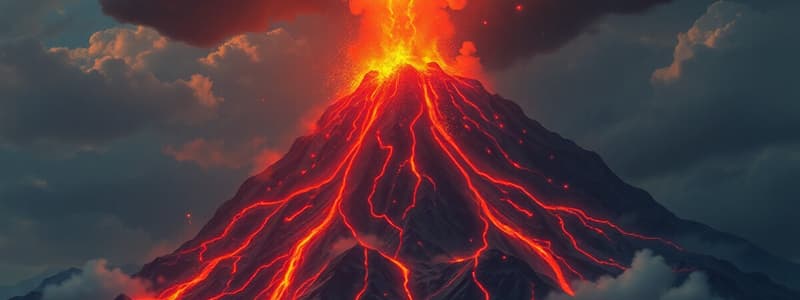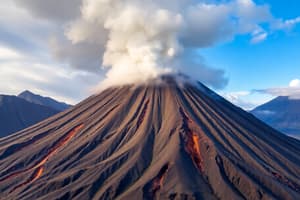Podcast
Questions and Answers
Which type of volcano is characterized by broad, gently sloping hills formed by low-viscosity lava?
Which type of volcano is characterized by broad, gently sloping hills formed by low-viscosity lava?
- Stratovolcano
- Cinder Cone Volcano
- Caldera
- Shield Volcano (correct)
What type of volcanic eruption is known for producing towering ash columns and pyroclastic flows?
What type of volcanic eruption is known for producing towering ash columns and pyroclastic flows?
- Plinian Eruption (correct)
- Strombolian Eruption
- Vulcanian Eruption
- Pelean Eruption
What volcanic hazard is caused by the rapid movement of volcanic ash and gas, often resulting in fatalities?
What volcanic hazard is caused by the rapid movement of volcanic ash and gas, often resulting in fatalities?
- Lava Flow
- Lahar
- Ash Cloud
- Pyroclastic Flow (correct)
Which of the following is NOT a benefit of volcanic activity?
Which of the following is NOT a benefit of volcanic activity?
Which type of volcano is small and steep-sided, formed from volcanic debris?
Which type of volcano is small and steep-sided, formed from volcanic debris?
Which volcanic eruption type is characterized by short, explosive bursts caused by gas bubbles in magma?
Which volcanic eruption type is characterized by short, explosive bursts caused by gas bubbles in magma?
What causes lahars during a volcanic event?
What causes lahars during a volcanic event?
Which of the following volcano types can result from hotspots?
Which of the following volcano types can result from hotspots?
Flashcards
Volcano
Volcano
A large opening in the Earth's crust through which molten rock (magma), ash, and gases escape from beneath the surface.
Shield Volcano
Shield Volcano
Broad, gently sloping volcanoes formed by low-viscosity lava that can travel long distances.
Stratovolcano
Stratovolcano
Steep-sided volcanoes built up by layers of lava, ash, and rocks, often resulting in explosive eruptions.
Cinder Cone Volcano
Cinder Cone Volcano
Signup and view all the flashcards
Caldera
Caldera
Signup and view all the flashcards
Hawaiian Eruption
Hawaiian Eruption
Signup and view all the flashcards
Plinian Eruption
Plinian Eruption
Signup and view all the flashcards
Pyroclastic Flow
Pyroclastic Flow
Signup and view all the flashcards
Study Notes
Volcanoes and Volcanic Eruptions
- Volcanoes are openings in Earth's crust where molten rock (magma), ash, and gases from below the surface escape.
- Typically found along tectonic plate boundaries, but some form over hotspots.
- Example hotspots include the Hawaiian Islands.
Types of Volcanoes
- Shield Volcanoes: Broad, gentle slopes formed from low-viscosity lava flowing long distances. Example: Mauna Loa, Hawaii.
- Stratovolcanoes (Composite Volcanoes): Steep sides built up from layers of lava, ash, and rocks. Often result in explosive eruptions. Example: Mount St. Helens, USA.
- Cinder Cone Volcanoes: Small, steep volcanoes made of volcanic debris. Example: Paricutin, Mexico.
- Calderas: Large crater-like depressions formed when a volcano collapses after a large eruption. Example: Yellowstone Caldera, USA.
Types of Volcanic Eruptions
- Hawaiian Eruption: Mild, fluid lava flows. Typically associated with shield volcanoes.
- Strombolian Eruption: Short, explosive bursts of gas from bubbles within magma.
- Vulcanian Eruption: More powerful eruptions with thick, sticky lava and ash clouds.
- Plinian Eruption: Very powerful and violent eruptions forming tall ash columns and pyroclastic flows. Example: Mount Vesuvius, 79 AD.
- Pelean Eruption: Characterized by rapid pyroclastic flows, often deadly.
Hazards of Volcanic Eruptions
- Lava Flows: Destroy surrounding environments.
- Ash Clouds: Cause respiratory problems and disrupt air travel.
- Pyroclastic Flows: Extremely hot, fast-moving clouds of ash and gas, highly destructive.
- Lahars: Mudflows created by volcanic ash mixing with water, often burying towns.
- Tsunamis: Underwater volcanic eruptions can sometimes trigger large waves.
Benefits of Volcanoes
- Fertile Soil: Volcanic ash enriches soil, making it suitable for agriculture.
- Geothermal Energy: Heat from magma can generate electricity.
- New Land Formation: Ongoing volcanic activity creates new landmasses, such as the Hawaiian Islands.
Studying That Suits You
Use AI to generate personalized quizzes and flashcards to suit your learning preferences.




